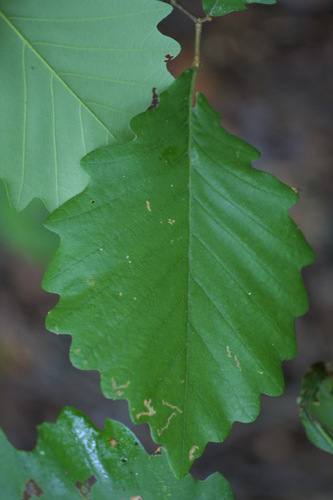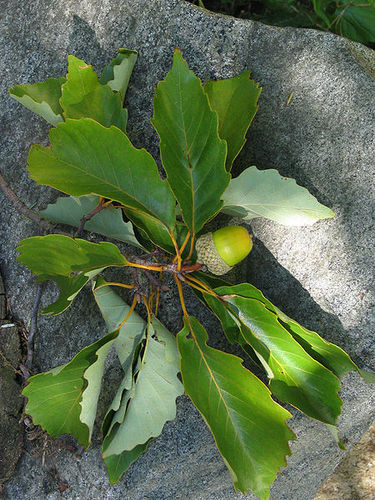Chestnut Oak : Lovely Leaves & Tasty Seeds

The leaf of the Chestnut Oak. Notice the pinnate venation pattern and gentle-toothed lobes that give it its distinctive look (Steven J. Baskauf, July 2002)
Lovely Leaves & Tasty Seeds
The leaves of the Chestnut Oak are oblong in shape, with several round-toothed lobes that are considerably less pronounced than the leaves of other Oaks such as the Pin Oak. Their colour is that of a beautiful dark yellow green until autumn, when they turn a dull, rusty orange before dropping to the ground. The size of the leaves ranges from about 4 to 8 inches long and 1 to 2 inches wide and is dotted with fine hairs that are slightly larger and erect along the pinnate venation pattern. They grow along the branch in an alternating pattern while flowers grow in groups at the base of their stem. The male flowers are a yellow-green colour that grow in 2 to 4 inch hanging catkins while the females are a reddish colour and grow in spikes.

More Chestnut Oak leaves showing the acorn and how it is attached to the tree (Mwanner, October 2005)
Another of the key characteristics of the Chestnut Oak is its acorns, which are among the largest acorns of all American Oaks capable of growing up to an inch and a half long. Their long rounded oval shape has either a yellow or polished brown colour with a bowl-shaped cup on one end that usually comes detached before the acorn reaches to the ground.
Chestnut Oak acorns are considered to be quite sweet for acorns. Though they are less favored by gray squirrels compared to the acorns of Red Oaks, grey squirrels prefer them over those of the White Oak. They are a favorite snack of numerous other forest-dwelling creatures as well (old-fashioned humans included) providing an essential food source for animals including turkeys, bears, mice, and deer among many others.
Of course, the designed purpose of the acorns is to spread the seed that lays within them, a process carried out by the combination of squirrels and gravity. They do not have a dormancy period meaning that they germinate right away in the fall, but unless the conditions are optimal the growth of the seedlings is very slow, usually little more than an inch or so per year.
